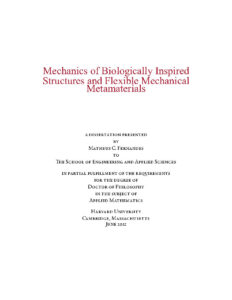Publications - Thesis
Publication Types:

Mechanics of Biologically Inspired Structures and Flexible Mechanical Metamaterials
Abstract
In this dissertation, I focus on exploring biologically inspired structures and the mechanics of flexible porous metamaterials by utilizing both experimental and computational methods. For the biologically inspired structures portion of this dissertation, namely chapters 2 and 3, I focus on the architectural details of the glassy skeletal system from the hexactinellid sponge, Euplectella aspergillum. In chapter 2, I show that this sponge’s meso-scale skeletal system, consisting of a square-grid-like lattice architecture overlaid with a double set of crossed diagonal bracings, exhibits the highest buckling resistance for a given amount of material when compared to related lattice structures. These findings are further confirmed thorough an evolutionary optimization algorithm, through which I demonstrate that the sponge-inspired lattice geometry occurs near the design space’s optimum material distribution. At another level of structural hierarchy, in chapter 3 I show that its complex maze-like organization of helical ridges that surround its main skeletal tube, not only provide additional mechanical reinforcement, but perhaps more significantly, deliver a critical hydrodynamic benefit by effectively suppressing von Kármán vortex shedding and reducing fluctuations in lift forcing over a wide range of biologically relevant flow regimes. By comparing the disordered sponge ridge geometry to other more symmetrical strake-based vortex suppression systems commonly employed in engineering contexts ranging from antennas to underwater gas and oil pipelines, I find that the unique maze-like ridge organization of the sponge can completely suppress vortex shedding rather than delaying the shedding to a more downstream location. These findings highlight the sponge ridge design’s potential benefit in engineering applications. Lastly, in chapter 4, I utilize similar experimental and computational methods to study the response of porous mechanical metamaterials with well-defined periodicity for their ability to exhibit complex behavior as a result of their non-linear deformation. Although it is well known that buckling-induced planar transformations occur in 2D porous metamaterials, here I explore the emergence of 3D morphologies triggered by mechanical instabilities in an elastomeric block with tilted cylindrical holes. I demonstrate that the 3D deformation of these structures can be leveraged to tune surface properties including friction and light reflection, thus providing a new experimental platform for investigating deformation-dependent dynamics for tribological and optical applications.

Mechanics of Subglacial Hydrology under Supraglacial Lakes and Ice Stream Shear Margins
Abstract
This thesis is broken down into two parts, both of which are focused on the mechanics of subglacial hydrology. The first part describes the opening behavior of a crack under a supraglacial lake, where a Finite Element Method model is presented to obtain the opening profile of a crack undergoing hydrostatic tension in an infinite power law creep material. The second part focuses on creating a numerical model for the opening diameter of Röthlisberger channels in ice stream shear margins, where antiplane strain rates are superimposed on in-plane stresses.
Design and Implementation of Wind Turbine Torque Measurement Device
Abstract
With the pursuit of understanding the torque on the shaft applied by the wind force on the blades, a torque measuring device was implemented to the turbine. This device is composed of two perpendicular strain gauges that measure continuous strain on the shaft. The orientation of the strain gauges gives measurement data on the torque as well as the RPM of the shaft. From these measurements we found a reverse torque phenomenon on the shaft when an emergency stop (e-stop) or the generator switches from low generation to high generation. This project uses wind data, and torque measurements data to analyze the effects created by the reverse torques on the shaft. This is a preliminary analysis to validate the need for a torque limiting device to be installed on the shaft. The device was designed to attach directly to the shaft as well as to withstand the brutal weather conditions that may occur in the nacelle.
